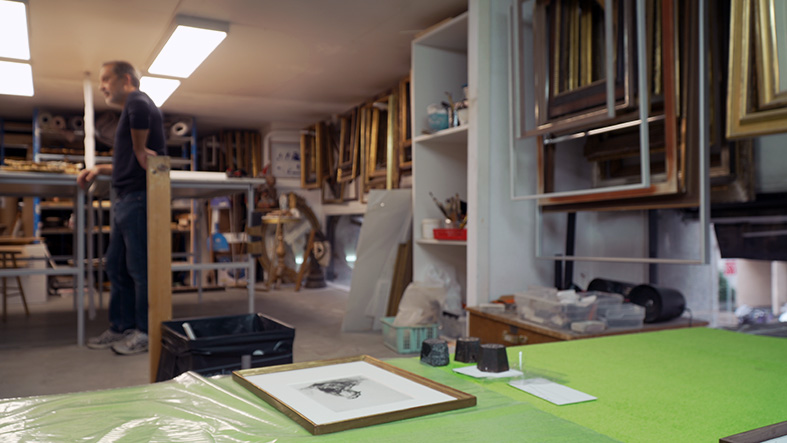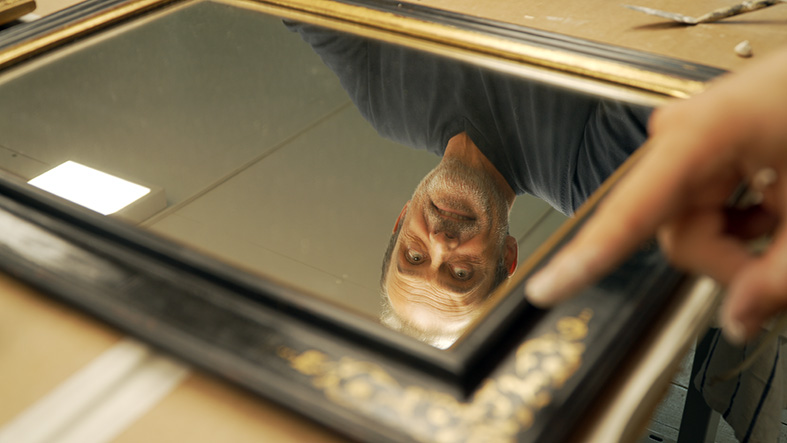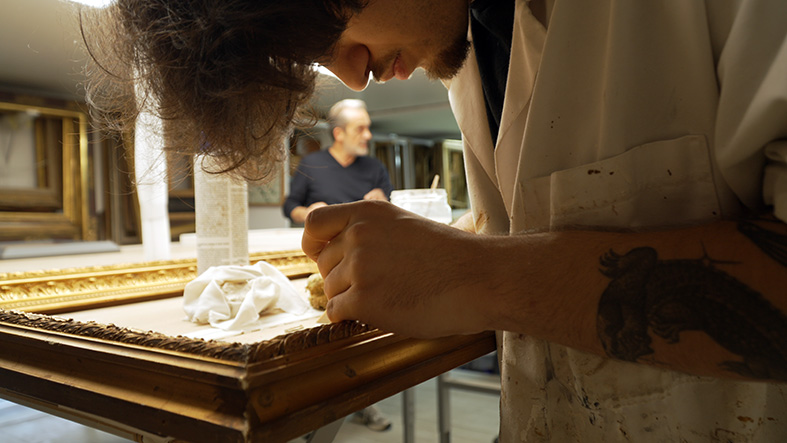Marco Colucci is a master craftsman in the world of art framing. Marco transforms wood – a material that is both ordinary and noble – into frames that protect and enhance works of art. With over 25 years of experience in the art world, Marco has developed his own expertise in handling wood. He uses a variety of techniques including engraving, painting and gilding to create frames that transcend their practical purpose. The frames become works of art in their own right. His mastery is not limited to creating aesthetically pleasing frames – he also has a deep understanding of the interaction between the art, frame and environment in which they coexist. Marco Colucci plays with dimensions, colours and depths, subtly influencing the perception of a work of art. At the heart of his craft, Marco Colucci combines traditional craftsmanship with contemporary artistic sensitivity.
You can also watch a video presenting his two workshops, and the practice of his profession. Go to Video

It’s generally said that every passion has its starting point. What initially drew you to the profession of art framer?
Marco Colucci I think my passion for works of art was certainly the main driving force. This fascination for art turned into a curiosity for everything that contributes towards its presentation and conservation. In my opinion, art framing is much more than the physical protection of works of art – it is an extension of the art itself.
Over the years, my approach as a framer has evolved into a true artistic expression. Each frame I create is designed to integrate perfectly with the artwork it surrounds, enhancing its beauty and respecting its integrity. For me, each frame is a work of art in its own right, crafted with the same passion and dedication that artists devote to their creations. By framing a work of art, I feel connected to its journey, and I modestly participate in its preservation and enjoyment for future generations.
What role does the Florence School play in your career?
MC The Florence School has played a crucial role in my professional development, particularly in my specialisation in the restoration of paintings. After my initial apprenticeship as a gilding framer, I felt the need to deepen my skills and understand more about art as a whole. The Florence School, with its rich artistic heritage and reputation for conserving works of art, offered me the ideal opportunity to do just that. There, I learned the delicate techniques and fundamental principles of painting restoration, which enabled me to develop a deeper appreciation for art conservation. This experience enriched my approach towards framing, giving me a broader perspective on how a frame can and should interact with the work it surrounds. The lessons learned at the Florence School are deeply ingrained in my daily work.
Every work of art requires special attention. What special considerations do you take into account when framing works with fragile surfaces or paintings mounted on stretcher bars?
MC Framing works of art, especially those with fragile surfaces or paintings mounted on stretcher bars, is a delicate exercise that requires great care and specific know-how. Before beginning the framing process, I carry out a meticulous assessment of the work’s state of conservation. This involves taking into account not only the nature of the materials used in the work itself but also its age, background and the conditions in which it has been conserved to date. These factors directly influence the choice of materials and framing techniques to be used. For example, an old or particularly delicate work requires materials that offer optimum support while minimising any risk of further damage or deterioration.
Moreover, the specific characteristics of the work’s period and style are also important considerations. Each artistic period has its unique characteristics and sensitivities, which must be respected and reflected in the frame. For example, framing a Renaissance painting requires a different approach to that needed for a modern or contemporary piece of work. Choices of design, colour, texture and even gilding technique must harmonise the work with its frame. I always try to create a balance where the frame and the work coexist, each enhancing the other.
Float mounting is an interesting technique. How is it particularly beneficial for certain works, and how does it affect the visual perception of the work?
MC Float mounting is a framing technique that I find particularly beneficial for certain works of art, because of its ability to preserve the integrity and enhance the visual presentation of the work. The use of Japanese paper hinges, which have a neutral pH, is a deliberate choice in this technique. This mounting method is ideal for the long-term conservation of works of art, as it reduces the risk of acidity and deterioration that can occur with other materials. In addition, float mounting allows the work to ‘breathe’, ensuring the adequate circulation of air around it.
From an aesthetic point of view, float mounting offers a unique and rewarding visual experience. By suspending the artwork in the frame, without covering the edges, this technique allows a complete appreciation of the work in its entirety. This approach reveals the aesthetic beauty and, in some cases, the imperfections of the work, offering a more authentic and complete visualisation.
What role does neutral Ph play in the materials you use, and why is it so important for conserving works of art?
MC The use of pH-neutral materials is fundamental to the framing process, especially for works on paper. The neutral pH in conservation materials means that they are free from acidity, which is crucial in preventing the deterioration of works over time. The acidity present in some materials, particularly those that are older or of inferior quality, can cause significant degradation of the artwork, including yellowing, embrittlement and discolouration of the paper. By choosing pH-neutral materials for framing and mounting, I ensure that the integrity of the artwork is maintained, protecting it from harmful chemical reactions that can occur over time. This is particularly important for works of art of historical value or those intended to be kept for long periods.

Your son has recently joined you and seems to be following in your footsteps. Do you feel proud to see him finding his way, or are you relieved to see him continuing your work?
MC Seeing my son join my workshop and follow in my footsteps in the art framing profession is a source of great pride for me. It’s much more than just passing on skills – it’s about sharing a passion and an artistic and craft heritage. It’s a pleasure to watch him develop his own style and approach while respecting the traditions and high standards that I’ve established over the years. It goes beyond simple pride – it’s the feeling of having succeeded in passing on a love and respect for art that has driven me throughout my career.

Marco Colucci’s website: HERE